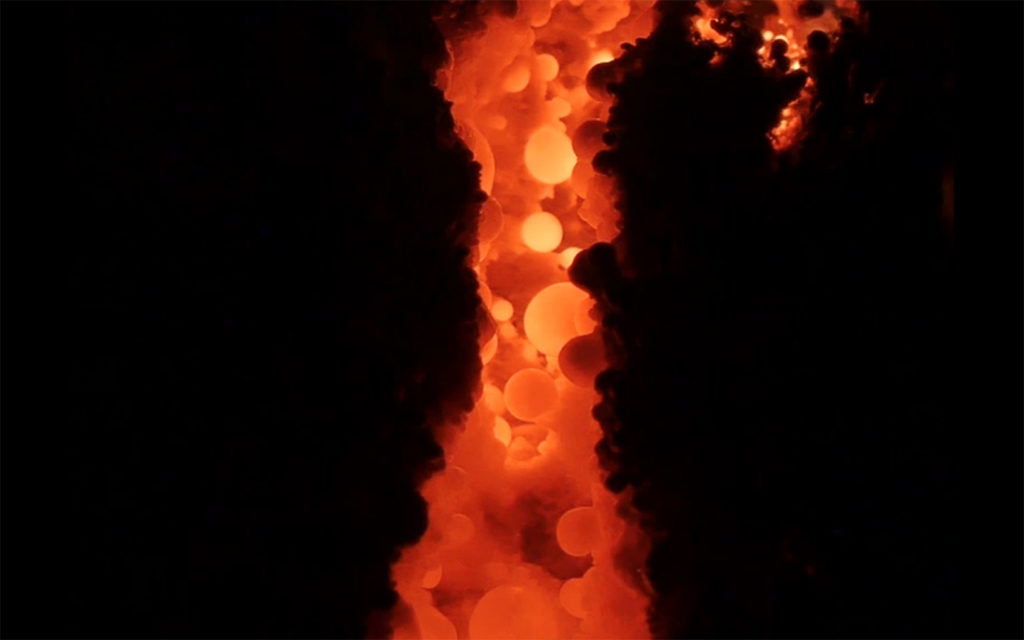This year’s BA graduates in product design displayed a cabinet of curiosities to show their final projects backed with rich research. In the first part of this two-part-article, we spoke to Gardar Eyjólfsson, who is the director of studies in Product Design and who lead the final project course together with Thomas Pausz. In this second part we highlight one exemplary project by BA graduate Kristín Sigurðardóttir.
Kristín Sigurðardóttir – The Alchemist
For her final project ‘Utile’, Kristín Sigurðardóttir created obsidian by recycling stone-wool, then made tiles from it. “The starting point was glass recycling. I got really interested in it when I found out about the non-existing glass recycling in Iceland and all glass is imported. To my surprise, bottles we return to the recycling centers are not sent abroad for recycling in other countries, like we do with the plastic and aluminum, and we do not have a glass factory in Iceland to recycle it either. So thousands of tons of glass have been used in landfills. Some experiments have been made to recycle the bottles, but none of them make it possible for the material to be recycled further. This is particularly sad as glass is 100% recyclable.”
She is quick to mention that the future looks brighter, and things are about to change for the better. Kristín started to think if some of the glass could be substituted for Icelandic glass? And what properties would that glass have? Many say that the volcanic obsidian, a sought out material found in the nature (isl. Hrafntinna) is the most natural Icelandic glass there is. Pitch black and rough in quality, it is ‘the opposite of the clear soda-lime glass we are used to’, Kristín says.
She found stone wool production to be the only glass industry in Iceland, with one factory located in Northern Iceland – Steinull hf. It uses local resources, namely three types of sand, of which 2/3 is made of black basalt sand collected from a beach just outside the factory. The ingredients are melted in an electric heater and transformed into fibers through spinning wheels, ‘almost like cotton candy’, Kristín explains.
“Stone wool is 100% recyclable, but in Iceland it has not been recycled – until now, that is.”
After some hands on research with this insulation material, Kristín found that it indeed has real potential for further recycling, not only to be processed into new stone wool, but to be transformed into a black glass related to the volcanic glass obsidian.
“Producing this new glass material from waste could be practical for Iceland, especially because of the fact that the natural obsidian is a rare volcanic glass, a material in high demand,” says Kristín.
The natural obsidian has a strong connection to the architectural history in Iceland, too, as crushed obsidian was used as coating on buildings in Iceland. A prime example of this use is the Icelandic National Theatre in Reykjavik.
“Today we cannot use the obsidian anymore without a specific permit which is really hard to get. What if we could use the new man-made version, that appears to be the same? If we do so, we could even use it on new buildings,” Kristín says.
She formed her new man made obsidian it into tiles to touch upon the local architectural history and comment on the new possibilities the material provides.
“My translation of the insulation material into tiles shows in a symbolic way that there is no longer need for conservative use of the material,” she says and continues, that “The project also shows the diverse properties we can find in one material and how a simple transformation can dramatically change our view on a material. From old and used insulation to beautiful black tiles, we are bringing the insulation material to the surface of the building, making it visible. The transformation has given the material different properties and a brand new purpose.”
Kristín says she will continue to experimenting and the goal is to add value to the local raw material. “There are so many possibilities and of course, always more to learn. Who knows? In the future we could even end up having a local glass production which only uses waste-material. This research has also made me wonder what treasures we can find in other waste materials around us that are left to be discovered, which is also a direction I would like to work in.”
Kristín’s project will be amongst eight projects, by graduates and current students of the Iceland Academy of the Arts, shown at the Dutch Design Week 2016.
For more info on Kristín and her work visit cargocollective.com/kristinsigurdardottir
Text by Sari Peltonen. Photos from the Kristín Sigurðardóttir and Iceland Academy of the Arts – IAA





